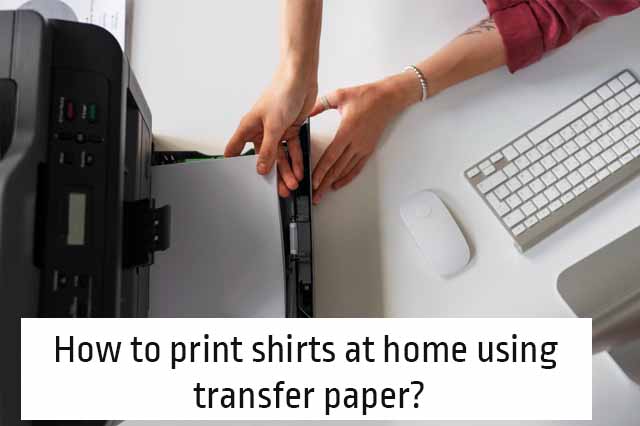How to print shirts at home using transfer paper?
Transfer paper is paper that can be ironed onto shirts or fabric.
You can print on the paper using an inkjet printer or a laser printer.
These papers can be bought at office supply stores or from printing suppliers.
Please note that the printing with these papers is not long-lasting – over time and washing, the print will begin to peel off. There are different qualities of this type of paper and some are more durable and some less durable.
So, what is needed to print with transfer paper on a shirt?
In order to be able to print using this method, we will need some materials:
- An empty shirt
- Inkjet or laser printer
- Ironing transfer paper
- Iron or heat press
What is the process of printing with transfer paper?
Design and printing
To get started, design the image you want to print on the shirt using graphics software (for example Photoshop) or an online design tool (for example Canva).
When preparing the graphics it is important to remember to use as high quality images as possible. In addition, you have to remember that all the parts of the paper will go to the shirt, so it is better that the graphics cover as large an area of the paper as possible.
Print the design on the iron-on transfer paper according to the instructions on the package.
It is important to remember that printing should be done as a mirror image.
Cutting the graphics
Note that this type of printing actually glues the top layer of the paper to the shirt.
This means that there will be a white rectangle on top of the shirt – even if nothing is printed on it.
When the printing is done on a white shirt this has less meaning, but if we print on a black shirt – we will want to cut the edges of the paper as close as possible to the printed area.
The cutting can be done with scissors or with a home cutting plotter (such as Silhouette).
ironing
Preheat the iron or heat press according to the instructions on the transfer paper.
Place the transfer paper on the shirt, making sure it is lined up correctly.
Use an iron or heat press to apply heat and press on the transfer paper, which will cause the design to transfer to the shirt.
Peeling:
Allow the shirt to cool completely, then carefully peel off the transfer paper.
Now your shirt should be printed with the design you created.
Keep in mind that the design may be fragile, so it is best to wash and dry the shirt inside out to protect the print.
it’s important to remember:
Iron-on transfer paper can be a quick and easy way to print a shirt at home, but the results may not be as high quality as other methods, such as screen printing.
In addition, transfer paper for ironing is not recommended for use on fabrics that cannot withstand high heat, such as polyester or nylon.
Types of transfer paper for shirts
Types of transfer paper for shirts are mainly divided into two categories: Transparent Heat Transfer Paper and White Heat Transfer Paper. Transparent Heat Transfer Paper is designed to be used on white fabrics and light colored fabric, as it is a thin and transparent film that would not show the color of the fabric underneath. Conversely, the White Heat Transfer Paper should be used for dark colored fabrics, as its thick and opaque nature can keep the color of the fabric from showing through.
Cutting machines such as Silhouette Cameo or Cricut are suggested when using either types of transfer paper for best results, as it would provide precise cutting with minimal waste. Both heat press and hand iron are suitable methods for applying the transfer paper, but heat press may produce more even temperature and pressure than hand ironing due to its automated settings.
Furthermore, depending on which type of paper you use; Transparent papers require mirroring before printing while White papers do not need mirroring before printing. Both types of papers have shiny back sides which should not be printed on. If you are unsure about how to apply your paper properly onto your shirt, there are many tutorials online that can help guide you through the process step by step.
When it comes to choosing what type of transfer paper is suitable for you, it is important to take into consideration factors such as budget, type of fabric being printed on and desired outcome in order to make an informed decision. With an understanding of these variables in mind, you will be able to select a suitable type of transfer paper that can bring your designs to life!
In conclusion,
Printing using transfer paper is a great way to make prints in a small amount and alone, but only if you know what its limitations are.
The advantages of this printing is the convenience of printing alone, the ability to print a small quantity and cheaply.
On the other hand, the durability of the print and the quality of the print are its main disadvantages.

